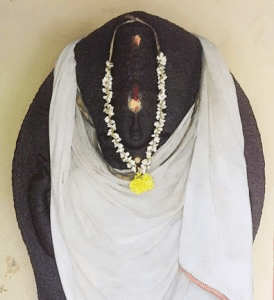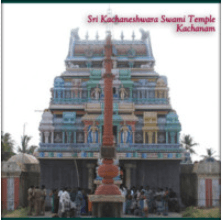This Shivastalam (abode of Paramasiva) administered by the Madurai Aadheenam.

The History
History goes that Lord Indra, the king of the Gods, deceitfully cheated on Sage Gautama and his wife Ahalya by impersonating him. Overtaken by lust and greed, Indra misusing his powers, took the Sage’s form and spent time with his wife in his absence. Condemning the act of Indra, Sage Gautama cursed him. Though Ahalya was chaste, with a view to get her further purified and liberated by Lord Rama Chandra, the direct incarnation of Lord Vishnu, Sage Gautama converted her into a stone. Devi Ahalya being converted into a stone spiritually signifies the unconscious state, which only the grace of God can destroy. Finally after a long time, she got the ultimate boon of being directly blessed by Lord Rama Chandra, who lifts the most fallen ones and liberates them. On the left is the deity called “Annamalaiyar” Shiva Linga.
For relief from the curse, Indra prayed to Lord Shiva, who advised him to make a Linga of sand and worship it performing abhisheka (offerings made to divine with water, milk and other oblations). Knowing it was not possible to perform the abhisheka to a sand linga, he had to undergo long years of suffering. Finally he worshiped the divine Cosmic Mother, Ambika and while embracing the Linga, he cried aloud to Lord Shiva for forgiveness, deeply repenting his misdeeds.
His fingerprints set on the Linga, as he sincerely prayed, and the Lord granted pardon and blessed him with a vision of “Tyagarajar”, a form of Paramasiva. As Indra’s fingerprints (Kai chinnam-rekhas in Tamil meaning “fingerprints”) were set on the Lord, this Shivalinga is named “Kai Chinneswarar” which came to be pronounced as Kachaneshwarar over time. He graces his devotees along with Mother Palvalai Nayaki.
There is also a shrine to Mahavishnu here, where a deity was discovered while excavating an arable tract of land belonging to the temple.



Deity of Medha Dakshinamurti – the Primeval Guru seated south-facing in this temple.
The Temple
The temple is over a 1000 years old, and the presiding deity of the temple is Lord Paramasiva, in the form of a Swayambhu (naturally formed) linga. The great sage, Agastyar, one of the Saptarishis (7 great sages of Hindu History) is also said to have been blessed here by Paramasiva.
The Utsavamoorti (celebration deity) here is called Tyagarajar (a name of Paramasiva). There is a shrine to Rishabha Dakshinamurti here, the same way as in Tiruvaimur in Tiruvarur.
This exquisite temple is a Maadakkoyil (built with a flight of stairs on the side) built at an elevation. It has 2 prakarams (outer precincts) with an attractive Rajagopuram (main gateway tower) and beautiful vimanams (shrines). Indra Teertham and the Vajra Teertham (temple tanks, sacred water body) are situated to the north and to the south of this temple.
To emphasize the beautiful truth that everyone should productively use his/her efficiency and education, Mother Saraswati – the Goddess of Wisdom and Mother Durga – the Goddess of efficient action are installed in the prakara of the temple followed by Jeshtadevi – the symbol of laziness and indifference, reminding the devotees to avoid these qualities and firmly stand with the former attributes.
Glory of the temple as sung by the poet Saints
This temple is the 122nd in the series of “Thevara Sthalams” meaning the 275 temples revered in the verses sung by the most prominent Tamil poet-saints, the chief Nayanmars (servitors of the Lord), namely Tiru Jnanasambandar, Appar and Sundarar. Its location is known as Kaichinam also known as Kachanam.
Temple Facts
Lord Shiva worshiped as – Kachineshwarar, Hrudaya Kamala Nathar
Ambal (Devi, His Consort) – Velvalaiyammai, Matsayadakshi
Sthala Vriksham (Sacred Tree) – Konkilavu
Teertham (temple tank, sacred water body) – Indra Teertham
Pathikam (10 verses of glory sung by) – Saint Appar
Festivals
Brahmotsavam is celebrated in the month of Vaikasi while Arudra Darisanam, Panguni Uthiram, Skanda Sashti and Navaratri are the other festivals celebrated through the year.
